| Black Powder Shotgun Shells
by Tom Bullock
The conventional shotgun cartridge
is designed for black powder. It was invented around 1870 when black powder
was the only kind of gunpowder that anyone had ever heard of. They didn't
even call it "black" powder. It works just fine with black powder, and
can still be loaded with black powder today. Here is how.
________________________________________
This is not a complete treatise
on reloading and is only about the unique problems caused by substituting
black powder for smokeless powder in shotgun shells. The reader is assumed
to be familiar with the tools and procedures for loading modern shells.
________________________________________
The main problems with black
powder relative to smokeless powder are:
Black powder takes up
more room in the shell than smokeless powder.
Old guns often have short
chambers; the shells must be cut short to match.
Plastic melts.
Smoke and Dirt.
Rust.
________________________________________
Black Powder is a simple
mixture of potassium nitrate, sulphur, and charcoal. The proper granulation
is named 'ffg'. It is also called '2F'. Anything finer is dangerous because
it burns too quick and the pressure climbs too high. Courser granulation
burns too slow. Buy black powder from muzzle loader dealers. Most general
gun shops do not stock it anymore; keep shopping. Some brands of powder
will produce little red-orange beads of molten sulphur that melt small
holes clear through a plastic case. Try another.
.
| Modern factory loads are
often labeled in 'drams equivalent'. That means that whatever charge of
whatever kind of smokeless powder is in there is supposed to produce the
same shot velocity as with so many drams of black powder. The peak gas
pressure is not the same and nether is the pressure curve.
The avoirdupois dram is the unit
of weight used to measure black powder. There are 256 drams in a pound
avoirdupois, 16 drams in an ounce, and 7000 grains in a pound. Take care
not to confuse 'dram' with 'drachm' or 'dram apothecaries' which are not
the same things at all. |
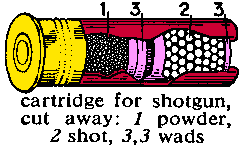 |
1 ounce = 16 drams = 437.5 grains.
1 dram = 27.34375 grains = 1.772
grams.
1 gram = 15.432 grains = 0.564
drams.
Conversion Table
Dram
savdp |
Grains
avdp |
Grams |
| 1 |
27 |
1.77 |
| 2 |
55 |
3.54 |
| 3 |
82 |
5.31 |
| 3 1/8 |
85 |
5.53 |
| 3 1/4 |
89 |
5.76 |
| 3 1/2 |
96 |
6.20 |
| 3 3/4 |
103 |
6.64 |
| 4 |
109 |
7.08 |
|
Charge Table
Adapted from various old books
and catalogs
| Gauge |
Black
Powder
drams |
Shot
Ounces |
Notes |
| .410 |
25 |
3/8 |
2 inch shells |
| .410 |
30 |
1/2 |
2 1/2inch shells |
| .410 |
35 |
5/8 |
3 inch shells |
| 28 |
1 1/2 |
3/4 |
|
| 28 |
2 1/4 |
3/4 |
|
| 20 |
2 1/4 |
7/8 |
|
| 20 |
2 1/2 |
1 |
|
| 16 |
2 1/2 |
1 |
Light |
| 16 |
2 3/4 |
1 |
Normal |
| 16 |
3 |
1 1/8 |
Heavy |
| 12 |
6 |
Blank |
1 thin card wad over powder; Nothing else |
| 12 |
2 1/2 |
1 |
Light |
| 12 |
3 |
1 1/8 |
Normal |
| 12 |
3 1/3 |
1 1/4 |
Heavy |
| 10 |
8 |
Blank |
1 thin card wad over powder; Nothing else |
| 10 |
4 |
1 |
Light |
| 10 |
4 |
1 1/4 |
Normal |
| 10 |
4 1/2 |
1 1/2 |
Heavy |
| 8 |
12 |
Blank |
1 thin card wad over powder; Nothing else |
|
Blanks loaded this way are plenty
loud; actually too loud to be realistic. The thin wad is just to avoid
spilling the powder. No confinement is necessary or desired. Only real
black powder will work; the modern substitutes will not burn fast enough
at low pressure. Even with no projectile blanks are dangerous at short
range so be careful.
Here is what to do if you take
a notion to exceed these loads: FORGET IT.
If you want modern magnum ballistics
you go buy a modern magnum gun and leave the old guns alone.
Many of the loads above were swiped
from the 1894
Sears Catalog and from the 1903
Sears Catalog.
________________________________________
Powder Density I made a
cylindrical powder measure with a depth of 1.000 inch, a diameter of 1.128
inches, and a volume of one cubic inch. I measured and weighed all the
powders I could get ahold of, and measured some power dippers.
Density of Black Powder
| Powder |
Size |
Grain per
cubic inch |
Notes |
| Goex |
Fg |
235 |
|
| Goex |
FFg |
231 |
|
| Goex |
Ctg |
252 |
Surprisingly Dense |
| Goex |
FFFg |
238 |
|
| Goex |
FFFFg |
235 |
|
| Dupont Superfine |
FFFFg |
232 |
70 years old and good as new |
| Dupont Superfine |
FFFg |
243 |
" |
| Kik |
FFg |
230 |
|
| |
|
242 |
Antique powder dipper |
| |
|
248 |
1970's T/C powder measure |
| Average |
239 |
|
|
|
Quite a variation. That is why you
measure powder by weight and not by volume. The average seems high to me;
235 is the value that I would likely use when making a powder measure.
________________________________________
Chamber Length. Many old
guns have short chambers. You will have to trim the modern shells to fit.
If a long shell is fired in a short chamber there will not be room for
the mouth of the case to open and the pressure will increase dangerously.
Shells are measured while open; not when crimped. Old barrels are seldom
marked with the chamber length; you must measure them to find out. The
modern 2 ¾ inch shells were introduced in the 1920's along with
the star crimp.
Some of the common chamber lengths
were:
16 ga - 2 9/16 (pretty
common)
16 ga - 2 3/4 (modern
star crimp)
12 ga - 2 1/2 (English)
Now called 65mm.
12 ga - 2 5/8 (very common
in America)
12 ga - 2 3/4 (modern
star crimp) Now called 70mm.
To measure the length of a 12 gauge
chamber make a metal bar 0.798 inches in diameter; the size of the forward
end of the chamber; and about 3 inches long. Slide it into the chamber
and measure how far it goes in relative to the breech face. Round that
down to the nearest standard size. Don't guess! Consult a gunsmith if you
can not perform this absolutely indispensable step by yourself.
|
Forward Chamber Diameters
| Gauge |
Inches |
mm |
| .410 |
0.463 |
11.76 |
| 28 |
0.614 |
15.60 |
| 20 |
0.685 |
17.40 |
| 16 |
0.732 |
18.59 |
| 12 |
0.798 |
20.27 |
| 10 |
0.841 |
21.36 |
|
|
The table gives the chamber diameters
at the forward end, just where the mouth of the shell lies after firing.
These are the modern minimum SAAMI dimensions.
A simple chamber length gauge may
also be made from a bit of heavy sheet metal. This one is double ended;
the pictured side is 12 gauge and the other side is for 16 gauge.
Also note that old shotguns often
have chambers that are shaped differently from modern ones. Here is a Cerrosafe
chamber cast of a Parker gun made in 1890. There is hardly any forcing
cone; the chamber simply ends with an abrupt step at 2 5/8 inch just like
a rifle chamber. It's diameter at the case mouth is right at the modern
minimum of 0.798. This is meant for a brass shell.
Cerrosafe is a bismuth based alloy
that melts at about 180°F. Just hold the barrel horizontal, clap a
bit of wood at the breech with your fingers to make a dam, and pour it
right in. Avoid the extractor. This makes a nice cast image of one side
of the chamber and you can see the reamer marks and rust pits and everything.
Get it at www.brownells.com.
________________________________________
Bore Size. The table shows
the nominal bore sizes of the various gauges.
The gauge number is the number
of bore sized lead spheres in a pound. (.410 is the only common exception.)
This is a holdover from the old days before good micrometers were invented.
They could make lead balls that were pretty near round and they could count
them and weigh them but they had a hard time measuring them accurately.
A 12 gauge gun takes a ball that weighs 1/12 of a pound; a 16 gauge takes
a one ounce ball. You can shoot round balls in a cylinder bored shotgun
but don't try it with a choked bore because the ball will stick in the
muzzle and that would be very bad.
Modern guns usually have bores that
are very close to the correct size but you cannot count on old guns being
bored right. Even when they were made right when new they might have grown
later. It was common practice to re bore guns that had leaded or rusted
bores in order to improve their shooting. A choke could be added to a non
choked gun by boring it out and leaving the muzzle the original size.
Re boring thins the barrel walls
and weakens it. In Europe a gun that had been re bored had go to straight
the Proof House for test firing before it could be returned to it's owner.
Sometimes a gun will be found with
bores that are actually undersize. English 12 gauge guns are sometimes
found with 13 gauge bores, and marked that way by the Proof House.
So it is important to measure the
actual bore size of any old gun before deciding whether to fire it or not.
If it is much over size then don't shoot it. The modern SAAMI tolerance
is 0.020 inch oversize. |
Standard Bore Sizes
Lead =709lbs/ft³
| Gauge |
Inches |
mm |
| .410 |
0.410 |
10.4 |
| 32 |
0.526 |
12.7 |
| 28 |
0.550 |
14.0 |
| 24 |
0.580 |
14.7 |
| 20 |
0.615 |
15.6 |
| 16 |
0.662 |
16.8 |
| 14 |
0.693 |
17.6 |
| 13 |
0.710 |
18.0 |
| 12 |
0.729 |
18.5 |
| 11 |
0.751 |
19.1 |
| 10 |
0.775 |
19.7 |
| 8 |
0.835 |
21.2 |
| 6 |
0.918 |
23.3 |
| 4 |
1.052 |
26.7 |
|
|
_______________________________________
| Proof Marks. Most of the
large European countries have proof laws. New or repaired guns must
be submitted to the official proof house where they are fired with very
heavy charges. Those that do not happen blow up are given Proof Marks.
They can tell you all sorts of things about where and when the gun was
made and what sort of load it was designed for and sometimes even the original
bore diameter and chamber length. The decipherment of proof marks is a
very large subject and if your gun has any you really should get the book
The
Standard Dictionary of Proof Marks by Wirnsberger and read up on them. |
... |
The Birmingham
Gun Barrel Proof House is still in operation and on The Web.
The United States does not have
a proof law; each factory has it's own private marks but they are boring
and no where near as elaborate as the European ones.
Plastic Shells. Plastic shells
get sort of melted on the inside when fired with black powder and will
not take a crimp after about 2 or 3 firings. Just accept it and throw them
away. Paper shells work fine; they were originally designed for black powder.
I normally use plastic. It is easier
to obtain and is easier to trim and crimp.
| Plastic Shell Trimming trick.
Make a brass disk 0.25 thick and 0.72 inch diameter (for 12 Gauge). Drill
and tap it with a ¼ x 20 screw thread. The soft metal is so it does
not scratch up your knife.
Ram it down on top of the
over shot wad in an untrimmed plastic shell. Hold the assembled shell tight
in one hand and with your other hand run a sharp pen knife around the case
flush with the disk. The blade lies flat on the disk and your thumb slides
on the outside of the case to guide it. It is sort of like peeling an orange.
Check the shell length to make sure it is correct for the chamber.
|
 |
Thread a ¼ inch stove bolt into
the disk and pop it out leaving the over shot wad in place with ¼
inch of excess case. It is now ready for a roll crimp.
Solid Brass Shells. These
used to be popular as they last dozens of firings and are easy to load
with simple tools. I have not actually loaded any brass shells but here
is what I have read:
In Shotgun Digest by Robert
Stack ISBN 0-695-80497-9 there is a so-so 10 page chapter (mostly pictures)
entitled "Brass Ain't Crass".
In The American Rifleman
October 1964 page 32 there is a much better 3 page article "Loading Brass
Shotgun Shells". It describes the various brass shells that were available
brand new in 1964 and the various primers to fit them. Tells how to seal
the over shot wad with water glass (sodium silicate). This stuff is still
sold in big drugstores as an egg preservative. Mix with 2 parts water and
put it in with an eyedropper and let it dry. Alcan used to make special
oversize wads just for brass cases; they don't any more, but Circle Fly
does. Black power is mentioned like it is normal.
Here is that article as three .gif
files:
bpsg-p1.gif
Page 1
bpsg-p2.gif
Page 2
bpsg-p3.gif
Page 3
If your web browser can't print
these files and get them to fit on paper then you might try saving them
to disk and printing them with some other program that can.
And here is another article from
The Dope Bag of November
1931.
Here is a picture of a 12 ga Brass
shell. The wall thickness is 0.011 - 0.012 inches and the length is
2.53 inches. Takes a Small Pistol primer. It has a balloon-head
and there is no base wad so there is plenty of room inside.
You can make brass shells for the
.410 shotgun by fire forming .303 British, .444 Marlin, or 9.3x74R rifle
cases.
Low base wad. The 'base wad' is
located down inside the shell around the primer. It has nothing at all
to do with the amount of brass on the outside. A low base wad is desirable
because it leaves more room for the black powder.
Primers. Black powder is extremely
easy to ignite. Any old primer that fits the pocket will do. There will
be no difficulties with poor ignition.
________________________________________
Wads. The modern plastic
wads take up too much space in the shell so you will probably have to use
the old fiber wads. Fiber wads can still be bought from dealers in muzzle
loading supplies. High quality fiber wads can sometimes be obtained from
Trap shooters who have long since converted to plastic but who could not
bring themselves to throw them away.
Wad Pressure. Black Powder
should be packed pretty tight but that is not critical. Even if left slightly
loose it will not give 'squib loads' like smokeless sometimes will.
Roll Crimp. If there is
sufficient space remaining in the case after the shot is added then just
go ahead and use the modern star crimp. If the shot leaks out through a
star crimp a nice trick is to stick a ¾ inch square of paper over
the shot and then crimp over it. That will seal the case without spoiling
the pattern.
If the shell is too short for a
star crimp you will have to use the old fashioned roll crimp. Get yourself
an old roll crimp tool. This is a typically a little machine that clamps
on the edge of a workbench. There is a chamber to hold the shell, a lever
to press it in, and a crank to turn.
Crimpers can often be found in antique
shops; they are about as common as parlor stereoscopes. The price seems
to depend on whether or not the shop owner can figure out what the hell
it is; an item labeled "Quaint Olde Tyme Vintage Tool" always seems to
cost more than a "Shell Crimper". They can also be found on eBay. There
is a separate size tool for each gauge. |
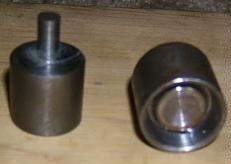 |
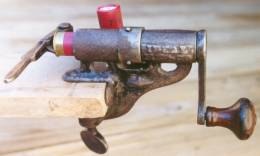
Old Ideal shell crimper |
The head of the Star Crimper made
by Lyman can be chucked in a drill press.
A roll crimp requires a special
over shot wad. It is made of thin but strong cardboard; strong enough to
stand recoil in a double gun but thin enough that it will not spoil the
pattern. This pattern spoiling is the main reason why modern shells use
the star crimp. Stick the card wad over the shot and get it nice and level.
There should be about 1/4 or 5/16 inches remaining in the case. Put the
shell in the crimping tool and press it in with the lever. Turn the crank
until a nice crimp is formed.
If you get a few bad crimps just
load them in the right hand barrel and shoot them first. Save the good
ones for the second shot. You don't want the crimp opening up under recoil
and leaking shot down the bore. |
| Cases that have never
been star crimped are easier to roll crimp. Shells that once held rifled
slugs work nice. Star crimped shells that have been shortened work OK.
Star crimped magnum shells work fine after shortening because all of the
original crimp is removed.
You can write your load data right
on the over shot wad. I use a black "china marker". Consider having a special
rubber stamp made.
The finished shell may be rendered
watertight by painting the wad and crimp with shellac, or hot wax, or cheap
nail polish, or water glass, or whatever. |
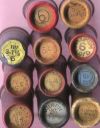
Wad Labels |
________________________________________
Loading Presses. Modern
loading presses are mostly usable. The main problem will be with the powder
bushings which seldom come large enough for black powder. Get around that
by measuring the powder by hand with a dipper. That's safer anyway. The
other problem will be with the star crimping die. It might have to be cut
off short to work with a shortened shell. A roll crimp will avoid that.
________________________________________
Velocity. Shot velocity
is about 1000-1300 feet per second; same as modern loads and the same as
it has been for the last two hundred years. There is just no point in driving
small shot much faster than the speed of sound because it will just slow
right back down again. It's not called the 'sound barrier' for nothing.
Recoil. Recoil is somewhat
greater with black powder than with an otherwise identical modern load.
It has to do with the greater mass of gas and dirt being ejected from the
muzzle. Initial acceleration is sharper due to the large initial surface
area of the grains which decrease as they burn. Fiber wads are heavier
than plastic too. Get used to it.
Modern smokeless powder is advertised
as 'progressive burning' giving 'lower recoil' and 'low flame temperature';
black powder has none of these modern advantages.
Noise. Black powder is a
lot louder than smokeless. Get used to it.
It is good for scaring people in
the trap squad. The first time I tried it it even startled the guy in the
concrete trap house.
Dirt. Black powder burns
dirty. Learn to like it. Expect the bore to be lined with a thick coat
of crud.
The chamber however will remain
clean, there will be no gas leaks at the breech, and there will be no jamming
problems even after hundreds of shots without cleaning.
________________________________________
Black powder substitutes.
I normally use only real black powder, but for extra money there are a
few modern powders to consider:
Pyrodex®. Substitute
it for black powder by volume, not weight. Use the 'RS' grade. Pyrodex®
is very hard to ignite. It must be packed very hard or else it will not
burn correctly. Consider adding a little real black powder next to the
primer to help it catch fire. It is very light and spongy stuff and can
be squeezed down to about 2/3ds of it's original volume. I guess it it
is made that way to mimic black powder's bulk. The residue is said to be
even more corrosive than black powder's.
Black Canyontm
powder was crap. They don't make it anymore.
Clean Shottm
powder is OK stuff. It behaves about like black powder. Contains no sulphur
so there is less stink and no holes burned in plastic shells. Dissolves
instantly in water. Less fouling, and what there is is not so hard and
crusty. Substitute by volume not weight. It must be packed tight to burn
well but not so very tight as Pyrodex®. It's residue is said to be
more corrosive though so take extra care in cleaning.
Clear Shot. Made by GOEX.
It's strange looking stuff. I haven't tried it yet.
American Pioneertm Powder.
I haven't tried it yet.
________________________________________
Modern Factory Load. Here
is a picture of the insides of a modern 12 gauge Gamebore brand cartridge.
The case is red paper with a thin plastic base wad, 65mm (2½ inches)
long and roll crimped. The base is plated steel. Overshot wad is cork with
plastic film on both sides; it should disintegrate on firing. Shot is 28g
(1 ounce) of #6. Fiber wad also has plastic film on both ends. Powder weighs
only 2½ drams and looks like FFFg. A very light load.
________________________________________
Clean Up. The fouling from
black powder is corrosive. It must be cleaned out very soon after shooting
or the bore will rust.
The fouling is water soluble; it
will not dissolve in oil. Only water will work. You can buy various special
cleaning products for black powder if you really want to but their active
ingredient is water.
| A typical late 19th century breech
loading shotgun will have a removable barrel containing only one movable
part, the extractor. Water will not harm this thing; it was designed to
be cleaned in water every day. If it is all rusty inside that is a sure
sign that one of it's former owners did not use enough water.
Make sure that the gun is unloaded.
Remove the forend. Remove the barrels. Wipe off the breech face and oil
it; You are done with that part. Take the barrel outside. Squirt water
down the bores with a garden hose to remove half of the dirt. Stick the
muzzle in a wooden (or plastic) bucket of cold water and run a wire brush
through a few dozen times. |
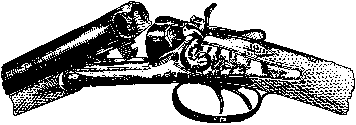 |
Change the water and repeat. It
is now clean. Note that the cleaning part is done with cold water.
Now get some very hot water. Pour a gallon or so down the bores. The point
of this is to heat the metal so that water will evaporate fast and dry
before rusting. If you don't feel like boiling water on the stove then
just take it in the bathroom and tie a sock around the breech and hang
it under the hot shower for half a minute like I do. Dry it inside and
out while hot, let it cool. Oil the bores, extractor, and lump. Oiling
the outside is optional; you might want to build up a nice patina. Reassemble.
Done. Easy.
I have never had any rust problems
with guns cleaned this way; but then I live in California and this severely
limits my experience with corrosion.
Without the new-fangled plastic
shot cup the shot will rub on the bore and lead it. Turpentine helps to
clean it out.
There is more info on Tom
Bullock's Web site.
|